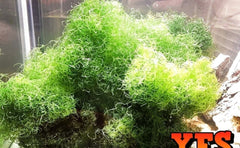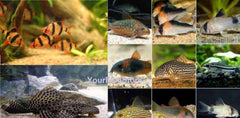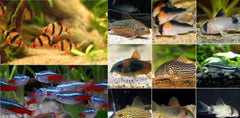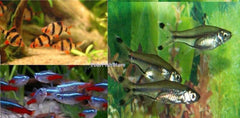X4 True Percula Clown Fish Pacakge - Free Bubble Anemone

x4 TRUE PERCULA CLOWN FISH PACAKGE - FREE BUBBLE ANEMONE - FREE SHIPPING
Minimum Tank Size: 25 gallons
Care Level: Moderate
Temperament: Semi-aggressive
Reef Compatible: Yes
Water Conditions: 72-78° F, dKH 8-12, pH 8.1-8.4, sg 1.020-1.025
Max. Size: 3"
The True Percula Clownfish Amphiprion percula is highly prized by most aquarists. It is one of the most sought after clownfish second only to its look-alike cousin, the Ocellaris or False Percula Clownfish Amphiprion ocellaris, which the popular "Nemo" clownfish was fashioned after. Yet even though these two look almost identical, they have distinct natural distributions, with very limited overlap. This handsome Orange Anemonefish makes an excellent aquarium specimen for any aquarist, from beginners to experts .
The Percula's coloration ranges from almost all orange or almost all white, to black and white and multiple variations of those 3 colors. Other common names it is known by include Orange Clownfish, Percula Clownfish, Percula Anemonefish, Blackfinned Clownfish, Eastern Clownfish, Eastern Clown Anemonefish, and Orange Anemonefish.
Notable color morphs, also found in the wild, are specimens that are almost all black. These are commonly known as the Black Crest Percula Clownfish and the Black Percula Clownfish. The middle of Black Crest's body is all black, including the dorsal fin, and it has very little orange. The Black Percula have traded their orange for the color black and there is very little orange on the body. In the wild these blacker varieties associate with carpet anemones of the Stichodactyla genus, and if not kept with this type of anemone in captivity the black color is known to fade.
The Percula Clown has been successfully bred in captivity and a number of "designer" clownfish combinations have emerged. The term Picasso Clownfish is a popular one, and just like a Picasso, there are typically no two fish in this group that are alike. Other varieties include the Mis-Bar Percula, Snow Onyx Percula, and the Platinum Percula Clownfish. You will pay a premium for the Picasso and other designer clownfish, but just as with the parents, their longevity and durability makes the investment worth it.
The Percula clown is a bit smaller than the Ocellaris, reaching only around 3” in length. In fact they are the smallest of all the clownfish, but because they are so similar in coloration to the Ocellaris these two are extremely difficult to tell apart. It takes a keen eye and sharp memory. Ocellaris Clownfish (False Percula), when in their original coloring, do not have the thicker, well defined black edging that surrounds the white bars that the True Percula Clownfish possesses. Other than color, the primarily distinction between the two is in the dorsal fin. The Percula has 10 dorsal spines (rarely 9) compared to 11 (rarely 10) on the Ocellaris Clown. Also the front half of the dorsal fin on the Ocellaris is higher.
These two clownfish are the only members of the Percula Complex. They share a similar lineage with each other and, believe it or not, with the Maroon Clownfish Premnas biaculeatus. You can see this in their swimming habits and body shape. Fish biologists have shown a common ancestry between these three fish using molecular phylogenetic analysis. This is a process used to analyze, among other things, DNA and protein sequences. They have even suggested that the True Percula and False Percula Clownfish be put into the Maroon Clownfish genus, due to the striking genetic similarities.
This aquarium staple can do well in a fish only tank or a mini reef. It is easy to care for and seems just as happy in a 10 gallon tank or 100 gallon tank. They are omnivores and will accept pretty much anything! Water movement should not be swift in the area they occupy, since they are not very good swimmers. They don't require special lighting. They can do well in small tanks because they aren't the most agile swimmers, and because they lack any desire to swim from their host. Thus they can occupy a smaller square footage, but to keep the water quality maintained in smaller spaces, regular water changes of 5% to 10% a week are advised. If keeping them with an anemone, the tank needs to be a minimum of 55 gallons or larger, enough to provide for its needs.
True Perculas get along with all other fish that are peaceful to smaller semi-aggressive fish. With an anemone, they are protected from obnoxious fish like 5 line wrasses and don’t seem to be as intimidated by larger fish. It is a good idea not to house them with groupers, larger eels or other fish that could swallow them whole. Also, do not keep with fish like dottybacks in a nano tank.
Compared to their cousins they are a bit more aggressive with their own kind, so will do best kept as pairs or singly. They can be kept with Skunk Clownfish, if both have an anemone and they are at least 2 feet apart. Avoid keeping them with Maroon Clownfish or with most clowns from the Clarkii complex unless the tank is very large. These fish are simply too aggressive unless the tank that is at least 6 feet long or more, and with the clowns on either end in their own anemone. In a 4 foot tank, Maroon Clownfish have been known to swim all the way over just to attack the other clownfish.
The True Percula Clownfish is not for the inexperienced, which poses a challenge for many new hobbyists. Percula Clownfish is often confused for the much easier to keep and more drably colored Ocellaris Clownfish. Therefore, care needs to be taken in choosing the appropriate clownfish for your home aquarium. The Percula Clownfish also has a thicker black outline to its white body stripes.
Native to reefs across Oceania, the Indo-Pacific, and off the coast of Australia, the True Percula Clownfish is also known as the Clown Anemonefish. In the wild, this member of the Pomacentridae family grows to about 4-1/2 inches; however, captive specimens rarely exceed 3-1/2 inches in length. In the home aquarium, the True Percula Clownfish requires an aquarium of at least 20 gallons with a fair amount of live rock.
*Free bubble anemone not covered by a live arrive guarantee

Customer Reviews
No reviews yet
Write a review
QUESTIONS & ANSWERS
Have a Question?
Be the first to ask a question about this.














